What you are looking at on this page is a Vento, but it isn’t a run-of-the-mill family sedan. It’s actually its evil twin – a purpose-built racing car, designed specifically to compete in the Turbo Class (TC4-A) category of the Indian Touring Car (ITC) championships. To sum it up, it’s stripped-down to save weight, has safety kit like a roll cage and a racing harness, is powered by a 210hp turbo-petrol motor, and is tuned to go very fast around a racetrack.
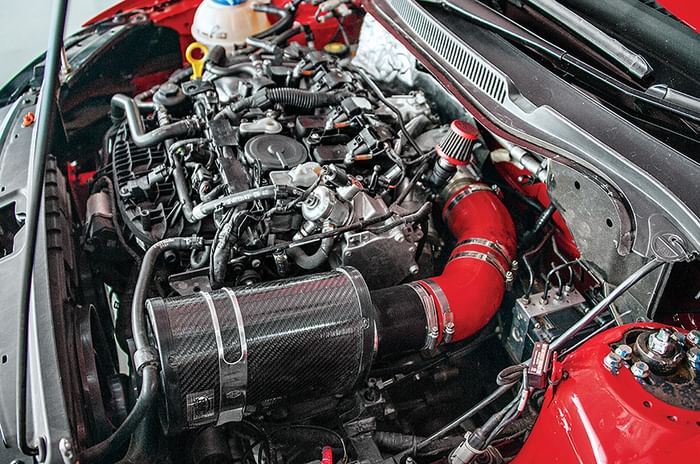
When I first laid my eyes on this Vento, its Flash Red paint job and blacked-out headlamps made it stand out amidst a sea of Ameo Cup cars. The tasteful 17-inch multi-spoke wheels, shod with slick racing tyres, its lowered stance and the functional air scoops on the bonnet were indications enough that this Vento meant business. VW has made-do without the massive tuner-car-like rear spoiler like the Ameo Cup car’s; and it doesn’t need one, I’m told (more on that in a bit).
A casual conversation with Sirish Vissa, head of VW Motorsport, had turned into quite a revelation for me. I learnt that fully prepped touring cars in India are very expensive – not Rs 5-6 lakh, but Rs 25 lakh expensive! And these are old Maruti Esteems and Honda Citys that we’re talking about. As their performance is turned up to 110 percent (read as extreme), their mechanicals take quite a toll during each race, so they aren’t very reliable; well, not at all. “And that’s exactly what this Vento is about to change”, says the confident Sirish, with a wide grin on his face.
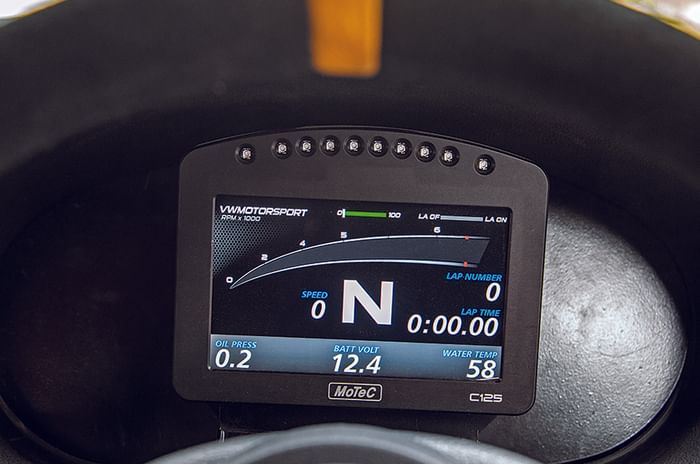
The cabin is completely stripped down to the bare minimum. What it has are essentials, like a racing seat with a four-point harness, roll cage, fire extinguisher and basic driver controls. Those aside, there are no carpets, door pads or creature comforts like air-conditioning and power windows to speak of. In fact, the VW Motorsport team has taken weight reduction so seriously that it tips the scale at 1,150kg (including the driver); that’s precisely how much the TC4-A category demands. Is there scope to reduce more weight? Sure, with the glass windows being replaced by plastics, doors and boot lid gotten rid of, and use of carbon fibre, it is easily possible to shed even more weight, “but that’s left for phase II of the project” Sirish revealed.
Getting into the driver’s seat is nothing short of an acrobatic task, due to the side impact bars (part of the roll cage) running the breadth of the door cavity. Though, once in the body-hugging OMP racing seat and buckled with the four-point racing harness, the driver is literally pinned down, irrespective of the Gs this car pulls around corners. The seat doesn’t adjust and neither does the Alcantara-wrapped sports steering. The digital instrument cluster is excellent when it comes to readability and there’s even a sweet F1-car-like LED gearshift indicator. The dashboard fascia has some large, yet easy-to-read buttons, including those for start-up, hazard lights and launch control, among others.
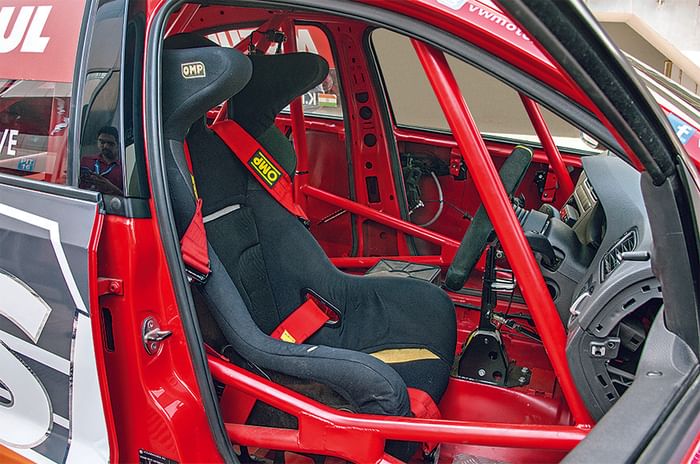
I start the Vento and this 210hp, 1.8-litre turbo-petrol engine (EA888) roars to life. And when I say roars, it’s loud. The side exhaust growls at idle, and as there’s no engine cladding or sound-deadening materials whatsoever, it feels as if I’m sitting on top of the engine. I press the clutch, pull down the sequential gear to shift from neutral to first and ‘clank’, the transmission selects a gear with a very mechanical feel. The racing clutch is heavy and needs some careful modulation to start off smoothly from idle. However, after that, you don’t need to depress the clutch anymore to shift gears. The revs start climbing as I gradually build speed out of the pit. As I’m in first gear, the moment I flex my right foot, the 350Nm of torque makes this car explode forward – ‘accelerates’ is too tame a description. Gearing is also very tall and the first gear goes well over 60; pull the sequential lever down and bam, with an aggressive jerk, it selects second gear. Within seconds, I’ve already maxed out second gear and it’s time to upshift to third. This 6-speed sequential transmission is the same as that on the Ameo, however, unlike in that car, there aren’t any functional paddles. The gear changes are just so raw and so aggressive, that they add to the overall race-car experience.
Before maxing out third gear, I reached the braking point of the corner, and experienced its anchors for the first time. This car has the optional race ABS fitted, so the bite point is a bit late; but the 334mm front discs and smaller discs at the rear infuse great confidence while shedding speed. There’s no electronic assistance for the steering and lock-to-lock is barely 180-degrees (not even a full turn), so it’s sharp and direct. In fact, halfway through the Buddh International Circuit (BIC) track, I was nicely in sync with the car. It communicated with me so well in terms of steering, braking and throttle feel, that I felt confident to push harder without being intimated by its sound or performance.
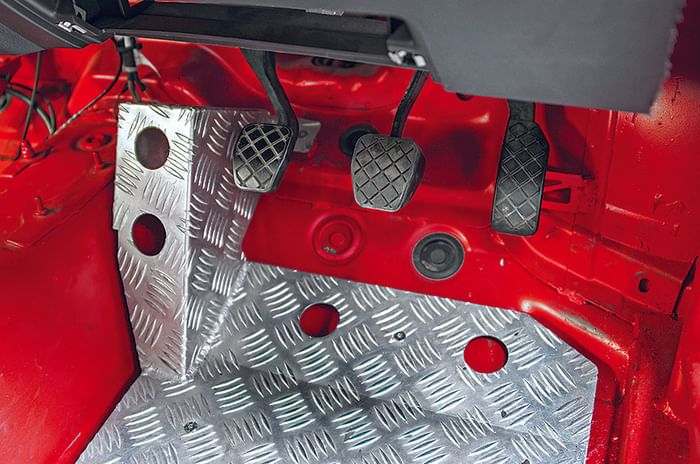
Folks at VW Motorsport claim that even though it makes only 5hp more than the Ameo, power delivery is peakier and stronger. TC4-A’s rules state that the air inlet needs to be restricted to 30mm – which means that power is limited to 210hp. But does it feel lacking in any way on the track? No way! This Vento is so responsive, a mere dab on the throttle makes it lunge forward like a scalded cat. It even hit 180kph on the back straight of the track rather effortlessly.
On the faster corners of the BIC, the car felt very grippy and eager to change direction. Sure, it’s a front-wheel drive, so there’s only so much VW engineers can do to maintain that fine balance and reduce understeer. It has worked well to a huge extent, as this car gets a wider rear track than the Ameo, its longer wheelbase and slipperier shape means that stability is quite fantastic, and it doesn’t need a rear spoiler for additional downforce. Credit also goes to the MRF racing slicks that latch onto the tarmac with a leech-like grip and ensure that power is cleanly transmitted to the wheels without much slippage. Narain Karthikeyan recently drove this car at our track day at MMRT (Chennai) to set a lap time; but it proved 1sec slower than the Ameo cup car despite being more powerful. Sirish explained that his team has been constantly fine-tuning (still setting up) and making improvements to the car.
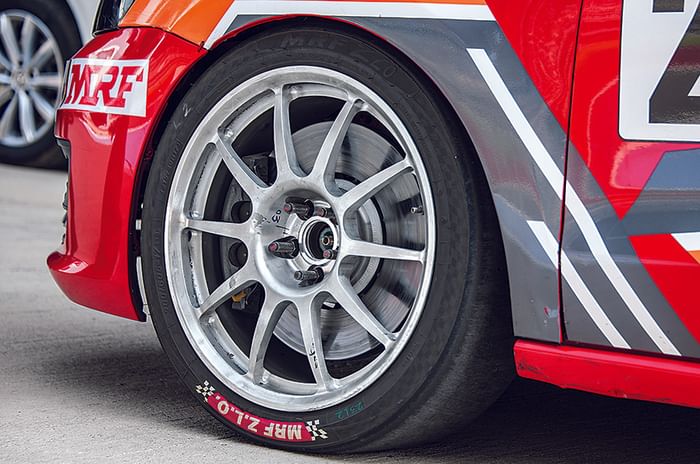
If you’re looking to participate in the ITC championships or simply want a fun weapon that you can hoon around on any racetrack or private road in India, VW will actually customise and sell you a Vento TC4-A for a princely sum of Rs 24 lakh. Add optional extras like the race ABS, digital instrument cluster and the 6-speed sequential gearbox, and you’re looking at a price of Rs 40 lakh. Of course, this car isn’t road-legal and there are no plans for it to be either, so practical it is not. But for those of you into racing, this could be a great choice – one that’s seriously fast and properly backed by nothing short of a factory team.






































